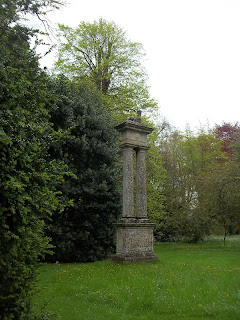Today we
finished our last bits of packing, and said a very fond and somewhat reluctant
goodbye to our hosts in Tetbury, Roz and Colin, with thanks both for their
lovely cottage and for their warm and helpful hospitality. We piled into the car with the luggage and
drove to Lacock Abbey, which not only had a medieval abbey converted to a Tudor
home (and the location of two Harry Potter movies), but also the Fox Talbot
Museum (an amazing man who made amazing contributions to the science of
photography) and an exhibit of pictures by Michael Palin.
Next, we
drove Ian, Dorothy and Beverley to their hotel in Heathrow, from whence they
will depart for Canada, and
Alanna and I drove up to our B&B in Stratford.
One of the
most striking things that I will remember about the Abbey isthe beautfiul grounds that surround the abbey. the village is equally beautiful, and has been used in several television and movie productions. We were there for another rainy day!
 |
| A building in Lacock |
 | |
| a sphinx in the gardens of the abbey |
 |
| the park |
Lacock Abbey
was founded in 1362 by Ela, Countess of Salisbury, in commemoration of her
husband, William Longespée, who was one of the signers of the Magna Carta. everything about the place reeks of important
history.
The original
nuns who lived there were all well-born ladies who had chosen to live a retired
religious lives – or had the choice made for them by their families.
 |
| A view down the cloisters |
After the
dissolution of the monasteries by Henry VIII, the estate (including the entire
village!) was purchase by William Sharington, who tore down the Lady’s Church,
used the stones to build a tower and more rooms, and converted the remainder of
the medieval building into a residence.
His granddaughter inherited the home, and her married surname was
Talbot. The Talbots lived in the house
and owned the village until Matilda Talbot gave the house and the village to
the National Trust in 1944, so that they might remain together as one piece. The house as displayed has rooms from many of the eras of the house's history.
In the1750’s
John Ivory Talbot rebuilt the Great Hall in the Gothic style, and the National
Trust shows it as though an Eighteenth Century Party had just been interrupted,
with a long white wig over a chair, wine stained glasses, and even a white
tablecloth stained with wine. Beverley
thought it was a bit messy, but Dorothy was really happy to find a seat by the
roaring fire.
 |
| Queen Victoria gave this desk to the family to acquit a debt incurred by her father. |
 |
| A mortar and pestle from the Fifteenth Century. The pestle weighs a TON! |
Although it
is out of the order that we saw it, we were impressed by the Fox Talbot Museum.
Fox Talbot was one of the bright lights of Victorian Society, good at
everything from a very young age, and a great contributor to both the arts and
sciences. He did important work in
science, including some early work in analyzing the components of substances by
analyzing their colour as they burned, helped to establish archaeology as a
science, and could read cuneiform. All
this, and he pioneered the modern photograph as well. I was really thrilled to take a picture
inside Lacock Abbey that was taken from the same position as one of the first
photographs every taken.
It was a
lovely morning, but all too soon it was time to head off to Heathrow to drop
Dorothy, Beverley, and Ian at their hotel.
I just hated to let Ian go,
especially as it means I have to drive “the tank” around Britain for
another week! (We tried to swap the huge
Ford for a smaller vehicle, but at first couldn’t get through, and then didn’t
hear back before we had to leave at 4:00 to beat rush hour.)
Our trip was
relatively uneventful, and we settled into the Bed and Breakfast with a chance
to check our email for the first time in days.
We couldn’t get tickets to the play this evening, so we are going to
watch a bit of telly and turn in, so that we can get ready for a truly full day
tomorrow.







No comments:
Post a Comment